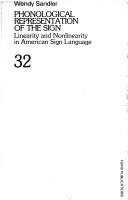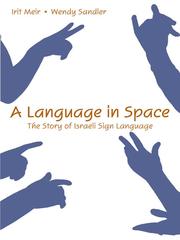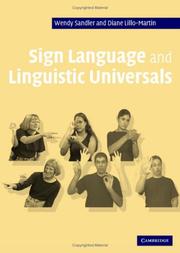| Listing 1 - 10 of 18 | << page >> |
Sort by
|

ISBN: 9067652873 9783110250473 3110250470 9783110133400 9789067652872 Year: 1989 Volume: 32 Publisher: Dordrecht, Holland Providence, R.I. Foris Publications
Abstract | Keywords | Export | Availability | Bookmark
 Loading...
Loading...Choose an application
- Reference Manager
- EndNote
- RefWorks (Direct export to RefWorks)
No detailed description available for "Phonological Representation of the Sign".
Grammar, Comparative and general --- Sign language. --- Phonology. --- Phonology --- Deaf --- Gesture language --- Language and languages --- Gesture --- Signs and symbols --- Sign language --- Linguistics --- Philology --- Grammar, Comparative and general Phonology
Book
ISBN: 2889630781 Year: 2019 Publisher: Frontiers Media SA
Abstract | Keywords | Export | Availability | Bookmark
 Loading...
Loading...Choose an application
- Reference Manager
- EndNote
- RefWorks (Direct export to RefWorks)
Digital
ISBN: 9783110250473 9783110133400 Year: 2011 Publisher: Berlin ;; Boston De Gruyter Mouton
Abstract | Keywords | Export | Availability | Bookmark
 Loading...
Loading...Choose an application
- Reference Manager
- EndNote
- RefWorks (Direct export to RefWorks)

ISBN: 1136679847 1281145734 1410616703 0429235518 0203810112 1299287182 1136679855 9781410616708 9781136679858 9781136679841 9780203810118 9780805855708 080585570X 9780805862652 080586265X Year: 2008 Publisher: New York, NY Lawrence Erlbaum Associates
Abstract | Keywords | Export | Availability | Bookmark
 Loading...
Loading...Choose an application
- Reference Manager
- EndNote
- RefWorks (Direct export to RefWorks)
This English version of A Language in Space: The Story of Israeli Sign Language, which received the Bahat Award for most outstanding book for a general audience in its Hebrew edition, is an introduction to sign language using Israeli Sign Language (ISL) as a model. Authors Irit Meir and Wendy Sandler offer a glimpse into a number of fascinating descriptions of the ISL community to which linguists and other researchers may not have access. An underlying premise of the book is that language is a mental system with universal properties, and that language lives through people.A
Israeli Sign Language. --- Israeli Sign Language --- Sign language.

ISBN: 9780521482486 9780521483957 0521482488 0521483956 9781139163910 1139163914 Year: 2006 Publisher: Cambridge Cambridge University Press
Abstract | Keywords | Export | Availability | Bookmark
 Loading...
Loading...Choose an application
- Reference Manager
- EndNote
- RefWorks (Direct export to RefWorks)
Sign languages are of great interest to linguists, because while they are the product of the same brain, their physical transmission differs greatly from that of spoken languages. In this 2006 study, Wendy Sandler and Diane Lillo-Martin compare sign languages with spoken languages, in order to seek the universal properties they share. Drawing on general linguistic theory, they describe and analyze sign language structure, showing linguistic universals in the phonology, morphology, and syntax of sign language, while also revealing non-universal aspects of its structure that must be attributed to its physical transmission system. No prior background in sign language linguistics is assumed, and numerous pictures are provided to make descriptions of signs and facial expressions accessible to readers. Engaging and informative, Sign Language and Linguistic Universals will be invaluable to linguists, psychologists, and all those interested in sign languages, linguistic theory and the universal properties of human languages.
Linguistics --- Sign language --- Semiotics --- Alphabet dactylologique --- Alphabet des sourds --- Communication gestuelle --- Dactylologie --- Deaf -- Sign language --- Doven -- Gebarentaal --- Gestes [Langage par ] --- Langage des signes --- Langage des signes pour les sourds --- Langage des sourds --- Langage gestuel --- Langage gestuel des sourds --- Langage mimique --- Langage par gestes --- Langage par signes pour les sourds --- Langue des signes --- Langue des sourds --- Mimique --- Signes [Langage par ] --- Sourds -- Langage par signes --- Sourds -- Langue des signes --- #KVHA:Gebarentaal --- Sign language. --- #KVHA:Taalkunde --- Linguistic universals --- Deaf --- Gesture language --- Language and languages --- Gesture --- Signs and symbols --- Universals (Linguistics) --- Typology (Linguistics) --- Universals --- Linguistic universals. --- Universals (Linguistics). --- Arts and Humanities --- Language & Linguistics --- Langage par signes --- Universaux (linguistique)
Book
ISBN: 303656246X 3036562451 Year: 2023 Publisher: Basel : MDPI - Multidisciplinary Digital Publishing Institute,
Abstract | Keywords | Export | Availability | Bookmark
 Loading...
Loading...Choose an application
- Reference Manager
- EndNote
- RefWorks (Direct export to RefWorks)
We are pleased to present a Special Issue of Languages on the topic of Sign Language Emergence. Sign languages are the only extant languages that can be caught in the act of being born and developing with no model, and they, therefore, offer the only empirical evidence for language emergence in human societies. We have brought together a collection of articles on emerging sign languages that contribute a great deal to our current understanding of this process.This Special Issue covers eleven different emerging sign languages around the world. The articles deal with several aspects of language emergence, including, most notably: (1) the relationship between the emerging language and the culture of the larger society; (2) the role of iconicity in the emergence of sign language; (3) the relationship between the shared context in a small signing community and the degree of variation in the vocabulary; and (4) the vulnerability of budding sign languages. Spoken creole languages are also young, but are different from emerging sign languages, in that the speakers of pidgins from which creoles are assumed to have descended already had native languages. One article compares the features of creoles and of emerging sign languages.We are especially pleased with the diversity and breadth of interests of the contributors to the volume, who are based on four continents. The languages that they cover are equally diverse in their geographical provenance.
Deaf --- Sign language. --- Education --- Speech. --- Gesture language --- Language and languages --- Gesture --- Signs and symbols --- Speech-reading --- Speechreading --- Communication --- Sign language --- Speech
Book
Year: 2019 Publisher: Frontiers Media SA
Abstract | Keywords | Export | Availability | Bookmark
 Loading...
Loading...Choose an application
- Reference Manager
- EndNote
- RefWorks (Direct export to RefWorks)
This eBook is a collection of articles from a Frontiers Research Topic. Frontiers Research Topics are very popular trademarks of the Frontiers Journals Series: they are collections of at least ten articles, all centered on a particular subject. With their unique mix of varied contributions from Original Research to Review Articles, Frontiers Research Topics unify the most influential researchers, the latest key findings and historical advances in a hot research area! Find out more on how to host your own Frontiers Research Topic or contribute to one as an author by contacting the Frontiers Editorial Office: frontiersin.org/about/contact
Science: general issues --- Psychology --- visual language --- sign language --- Gestures --- multimodal communication --- compositionality --- Visual prosody --- language acquisition --- Multimodal representation
Book
Year: 2019 Publisher: Frontiers Media SA
Abstract | Keywords | Export | Availability | Bookmark
 Loading...
Loading...Choose an application
- Reference Manager
- EndNote
- RefWorks (Direct export to RefWorks)
This eBook is a collection of articles from a Frontiers Research Topic. Frontiers Research Topics are very popular trademarks of the Frontiers Journals Series: they are collections of at least ten articles, all centered on a particular subject. With their unique mix of varied contributions from Original Research to Review Articles, Frontiers Research Topics unify the most influential researchers, the latest key findings and historical advances in a hot research area! Find out more on how to host your own Frontiers Research Topic or contribute to one as an author by contacting the Frontiers Editorial Office: frontiersin.org/about/contact
visual language --- sign language --- Gestures --- multimodal communication --- compositionality --- Visual prosody --- language acquisition --- Multimodal representation
Book
Year: 2019 Publisher: Frontiers Media SA
Abstract | Keywords | Export | Availability | Bookmark
 Loading...
Loading...Choose an application
- Reference Manager
- EndNote
- RefWorks (Direct export to RefWorks)
This eBook is a collection of articles from a Frontiers Research Topic. Frontiers Research Topics are very popular trademarks of the Frontiers Journals Series: they are collections of at least ten articles, all centered on a particular subject. With their unique mix of varied contributions from Original Research to Review Articles, Frontiers Research Topics unify the most influential researchers, the latest key findings and historical advances in a hot research area! Find out more on how to host your own Frontiers Research Topic or contribute to one as an author by contacting the Frontiers Editorial Office: frontiersin.org/about/contact
Science: general issues --- Psychology --- visual language --- sign language --- Gestures --- multimodal communication --- compositionality --- Visual prosody --- language acquisition --- Multimodal representation
Book
Year: 1995 Publisher: Dragvoll University of Trondheim. Department of linguistics
Abstract | Keywords | Export | Availability | Bookmark
 Loading...
Loading...Choose an application
- Reference Manager
- EndNote
- RefWorks (Direct export to RefWorks)
| Listing 1 - 10 of 18 | << page >> |
Sort by
|

 Search
Search Feedback
Feedback About UniCat
About UniCat  Help
Help News
News